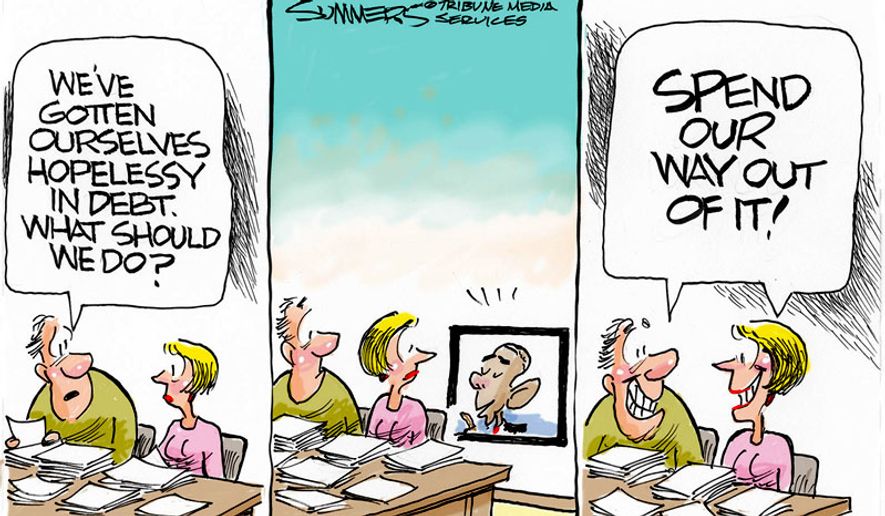What do $500,000 worth of melting walls in Afghanistan, a $600,000 public-speaking training course for teenagers in Morocco, and a series of Star Trek-themed spoof videos for IRS employees all have in common? They’re all examples of absurd projects the federal government financed with our tax dollars; they’re a large part of the reason we’ll never bring the federal budget into balance until Washington decides to make serious changes to its spending habits; and they’re exactly the kind of wasteful spending that would come to a stop if Congress would enact a budget based on the Penny Plan.
Each example is a reminder of how unaccountable our government is to us, the taxpayers. Imagine for a moment the consequences in the private sector if someone spent half a million dollars to build a wall made of sand bricks that was, predictably, destroyed within four months by rain. Waste and fraud that would never be tolerated in the private sector have become all too routine and commonplace in Washington.
Late last month, the United States reached an unhappy milestone: for the first time in our nation’s history, the federal debt exceeded $19 trillion. And looking just a short distance in the future, the debt is expected to reach $20 trillion before President Obama leaves office next January. For perspective, the debt was at $10.8 trillion when he was sworn into office back in 2009. The federal government has been on a spending and borrowing binge for decades – made far worse over the last eight years – and the result is that future generations will be saddled with the inescapable burden of a debt they didn’t rack up.
The federal debt and the profligate spending habits behind the debt are emblematic of the entire culture of Washington, D.C. – unaccountable, irresponsible, and excessively wasteful.
Americans are increasingly distrustful of Washington, D.C. and, as a result, the 2016 presidential election is being driven by anti-Washington and anti-establishment sentiments. Watching the Republican nominating process, one is struck by just how intensely GOP voters dislike “business as usual” in Washington, and not surprisingly, they are clamoring to the two most anti-establishment candidates – Donald Trump and Texas Senator Ted Cruz.
Americans understand debt. And we also understand that managing debt requires discipline and restraint. According to the Pew Charitable Trusts, 8 in 10 Americans are in debt. Americans tackle their personal debt, most commonly, by reducing spending, avoiding accruing new debt, and living within a budget. Politicians in Washington, however, consistently take the opposite approach. Congress sometimes goes years without passing a budget, and, as it did this past November, regularly suspends the debt-ceiling limit, which allows the federal government to borrow as much money as it wishes.
One of Tea Party Patriots’ three core pillars, in addition to personal freedom and economic freedom, is the pursuit of a debt-free future because we believe we have a responsibility to ensure that future generations will not be enslaved by our debt. As a concrete measure to promote a debt-free future, we are championing the Penny Plan, a simple budget construct that requires the federal government to spend one penny less out of each dollar spent every year for the next five years. It almost sounds too simple, but the Penny Plan would dramatically reduce spending. By some estimates, the Penny Plan would cut spending by more than $7.5 trillion over a 10-year period. Senate Budget Committee Chairman Mike Enzi supports this proposal as the best and easiest way to balance the federal budget within five years. Despite Washington, D.C.’s penchant for overcomplicating everything, budget slashing is one area where simple truly is better.
One of the best aspects of the Penny Plan is that it first targets duplicative or wasteful government programs that abound in the federal budget. So, for example, the sand-brick walls and IRS Star Trek spoof videos could be put on the chopping block and no one would ever miss them.
We’ve conducted extensive polling on solutions and reforms to address our country’s biggest problems, and the Penny Plan appeals to a wide swatch of American voters across party lines. Among all likely voters, it earns 78 percent support; among Republicans, 88 percent support; among Tea Party supporters, it receives 94 percent support.
The United States has a serious spending problem. The Penny Plan is a serious – and surprisingly painless – solution that all Presidential candidates should be discussing.




Please read our comment policy before commenting.